Yanagawa Shigenobu II (active circa 1820s-late 50s)
No. 6, Grinding Ink (Roku, Surusumi), from the series An Array of Famous Horses (Meiba soroe), 1834, year of the horse
Woodblock print, surimono, embellished with metallic pigments and embossing
Shikishiban:
21 x 18 cm.
8 1/4 x 7 1/8 in.
21 x 18 cm.
8 1/4 x 7 1/8 in.
Signed: Nisei Yanagawa Shigenobu ga
Privately published, 1834
Privately published, 1834
Sold
A woman kneels in front of a red cloth she has laid out with paper and fans onto which she is about to inscribe calligraphy or paint pictures for her...
A woman kneels in front of a red cloth she has laid out with paper and fans onto which she is about to inscribe calligraphy or paint pictures for her kakizome, the first writing of the New Year. In her right hand is an ink stick which she grinds onto an ink stone. A box to her right contains small ceramic cups holding pigments of various colours and brushes lay beside.
This print is from a set published in 1834, a Horse Year, hence the set's title Meiba zoroe (An Array of Famous Horses). Each design features a gourd-shaped series title cartouche over a fan cartouche containing the individual print title.
The three poems on this print have been translated as:
tsuyokaranu
fude no susabi o
otomego no
tehon ni utsusu
kaze no aoyagi
With a wavering brush,
the girl tries her hand
at calligraphy practice,
copying old models inspired by a willow swaying in the wind.
--- Shikosha Mimihiko
hatsuyume ni
mishi omokage ya
kakizome ni
hiraku ogi wa
Fuji no yamagata
As in the first dream
of the New Year,
the opened fan
for first writing practice
resembles Mt. Fuji's shape
--- Chokintei Aoki
murasaki no
Akama suzuri ni
fude somete
egaki somuran
sumire sawarabi
Into the purple-tinted
Akama inkstone
the painter dips his brush
to create violets
and bracken sprouts.
--- Shakuyakutei
See John T. Carpenter (ed.), Reading Surimono: The Interplay of Text and Image in Japanese Prints, (Leiden, 2008), cat. no. 239, p. 362.
All seven prints from the set are in The Museum of Fine Arts, Boston, go to:
- No. 1, Matsukaze (Ichi, Matsukaze)
- No. 2, Throwing Dice (Ni, Ichi roku)
- No. 3, Under the Tree (San, Konoshita kage)
- No. 4, Usugumo (Yon, Usugumo)
- No. 5, Silver Coins (Go, Nanryo)
- No. 6, Grinding Ink (Roku, Surusumi)
- No. 7, Applying Dye (Shichi, Sometsukige)
This print is from a set published in 1834, a Horse Year, hence the set's title Meiba zoroe (An Array of Famous Horses). Each design features a gourd-shaped series title cartouche over a fan cartouche containing the individual print title.
The three poems on this print have been translated as:
tsuyokaranu
fude no susabi o
otomego no
tehon ni utsusu
kaze no aoyagi
With a wavering brush,
the girl tries her hand
at calligraphy practice,
copying old models inspired by a willow swaying in the wind.
--- Shikosha Mimihiko
hatsuyume ni
mishi omokage ya
kakizome ni
hiraku ogi wa
Fuji no yamagata
As in the first dream
of the New Year,
the opened fan
for first writing practice
resembles Mt. Fuji's shape
--- Chokintei Aoki
murasaki no
Akama suzuri ni
fude somete
egaki somuran
sumire sawarabi
Into the purple-tinted
Akama inkstone
the painter dips his brush
to create violets
and bracken sprouts.
--- Shakuyakutei
See John T. Carpenter (ed.), Reading Surimono: The Interplay of Text and Image in Japanese Prints, (Leiden, 2008), cat. no. 239, p. 362.
All seven prints from the set are in The Museum of Fine Arts, Boston, go to:
- No. 1, Matsukaze (Ichi, Matsukaze)
- No. 2, Throwing Dice (Ni, Ichi roku)
- No. 3, Under the Tree (San, Konoshita kage)
- No. 4, Usugumo (Yon, Usugumo)
- No. 5, Silver Coins (Go, Nanryo)
- No. 6, Grinding Ink (Roku, Surusumi)
- No. 7, Applying Dye (Shichi, Sometsukige)

